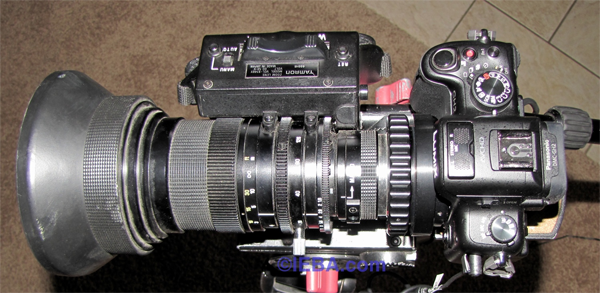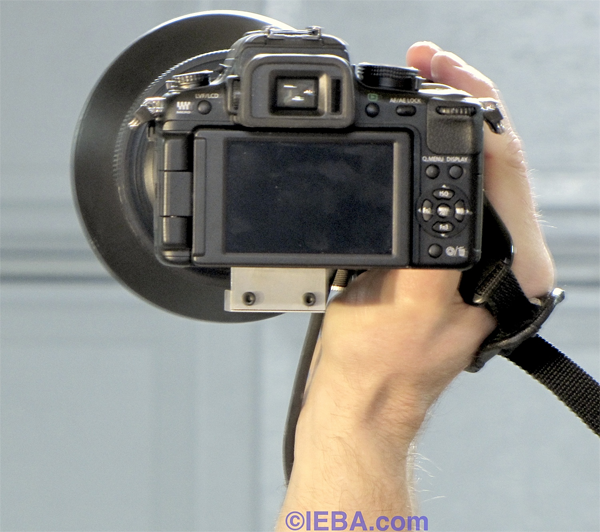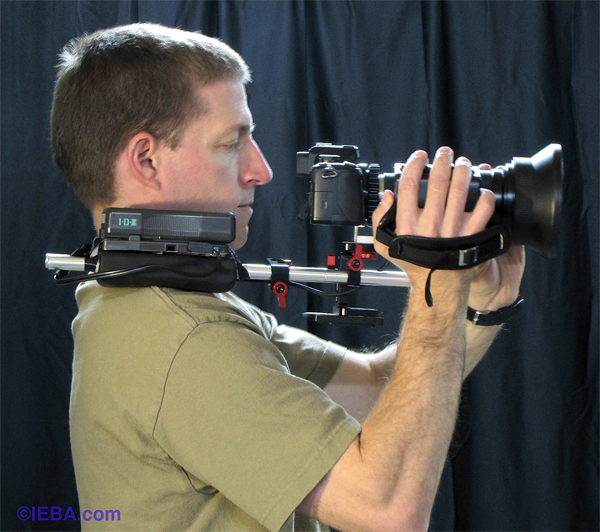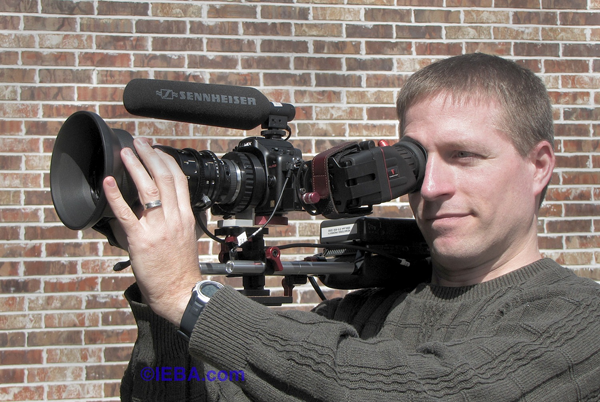Adapting ENG Lenses to DSLR Production, Part 2: Power & Rigging
Adapting servo zoom ENG lenses to your DSLR rig with suitable rails and power makes for a smooth transition from prosumer camcorder to large-sensor video camera.
The ENG Lens Grip
The ENG lens gives you a big, comfortable grip right in the middle of the lens.

The weight is to the left of your hand, but the ENG lens has a big, comfortable grip.
I've used an on-shoulder ENG camcorder for hours and never had a problem with the grip. Of course, with that type of camcorder, the weight of the camera is primarily on the shoulder and your right hand is merely "steering" the camcorder by way of the lens. With a DSLR, all the weight is in your hand and on your arm. Also, when I started to tried to use the DSLR this way, I found out one new caveat I had not considered: rotational balance.
When you put a big camcorder on your right shoulder, it wants to rotate to the right, away from your head, and off your shoulder. When you put your hand in the lens grip, for lift support, you're providing an opposing force. The grip on the right side of the lens wants to rotate counter-clockwise, which counterbalances the big camera on your shoulder. Without the big camcorder there to counteract the lens, there's torque pulling the lens and camera down.

Centering your hand under the ENG lens balances it.
One solution is to put your hand more underneath the lens than next to it. This works well for quick handheld work. Another option is to use a shoulder brace or some sort of DSLR rig to balance out the system.
Rails and Riser
I purchased a set of rails that provided far more than I ended up needing. The kit I bought has two handles, an offset to put a DSLR in front of my face, and so on. I don't need the kit's offset because (unlike most DSLR models) the GH2 has a tilt-swivel screen. I don't need the kit handles because I'm using the ENG lens, which is 100x easier to grip and use than any DSLR handle I've gripped.
But I do need the shoulder pad, rails, and center riser for the camera. I could conceivably use a focus puller, but an ENG lens focuses so easily that there's no real point to spend several hundred dollars for a focus puller. When I mount my battery on top of the shoulder brace, and mount the lens on the rails, my rig looks like this:

This is the ENG-DSLR with plenty of power.
Shooting With a Loupe Outdoors
For use outdoors, a loupe or external electronic viewfinder would make it much easier to see what the shot is. There are many solutions available, including large and small LCD screens. Some of the latter can also be used as electronic viewfinders.
Adding a loupe to my DSLR's swing-out screen makes this setup even more like a traditional, on-shoulder ENG camcorder. It's comfortable, easy to use, and easy to focus, and I can zoom and rack focus at the same time because I'm able to use both my hands to operate the lens.
The start/stop on the camera is on the right side, so I have to reach over with my left hand, but I look forward to adapting the lens cable to also toggle start/stop on the camera. This would make this setup super-convenient to use.
Here's the kit using the Varavon "Supporter" EX eyepiece which is specifically designed to support itself when you use it with these swing-out screen DSLRs. You can tilt it up and down, adjust the diopter, and lock everything lock into place--without actually hanging on the LCD screen. It supports itself and essentially "hovers" around the LCD screen.

The Varavon Supporter loupe makes outdoor shooting very easy.
Mounting Plate Issues
A new challenge is that the mounting plate for the camera is not designed for the torque put on it by holding everything by the ENG lens. The rails kit is designed so that you use a handle connected to the rails. The DSLR is just supposed to sit there, untouched. The camera mount is lightweight and the thin layers of cork flex and twist easily when moving everything around by the ENG lens grip. I'm already on the hunt for a proper, heavier-duty replacement.
Related Articles
DSLRs have become the standard by which current and future large-sensor camcorders are judged. But as we adopted DSLRs and primes to produce more "filmic" video for our clients, we left something critical behind: the feathery smooth servo zoom that serves feature film producers so well. So how do you get that capability on your DSLR?